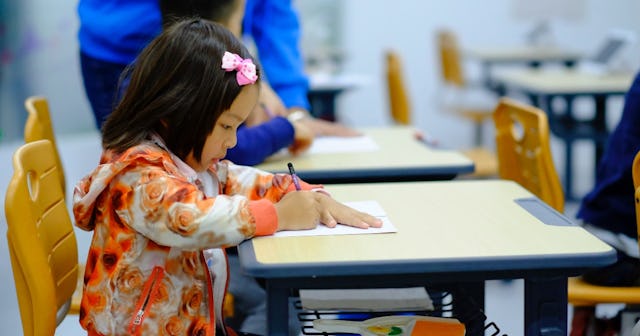What Is Information Processing Theory, And How Can It Help At Home?

Memory is one of those things that you don’t really think about… until it becomes a problem. Chances are, you’ve already experienced this yourself in the form of “pregnancy brain” or “mom brain.” Plus, you’ve probably witnessed memory at work in another way: watching your child learn, and then recall and retain information. This is an important part of their cognitive development — and something you help reinforce when you point out and name different objects in a room, or while reading a book. Since the 1950s, an approach to this called “information processing theory” has aimed to explain how humans process information and turn it into memories.
As a parent, aka a person who wants to learn as much as possible about their kid, you’re bound to find this model fascinating. So, prepare to soak up some more info, Mama! Here’s what to know about information processing theory, including the definition, approaches, and examples.
RELATED: Free Online Memory Games Perfect for Every Age
What is information processing theory?
As the field of psychology developed throughout the first half of the 20th century, the focus was primarily on behaviorism. This approach involved learning from human behaviors that could be observed. One of the downsides? It made understanding how a person’s mind works essentially impossible, given that it wasn’t something that could be easily observed. And that’s where the information processing theory approach comes in.
By the 1950s, very early computers started to be used in professional settings, presenting cognitive psychologists like George A. Miller with a new way of thinking about how humans process information. His 1956 theory was that the human mind works a lot like a computer: collecting, saving, modifying, and retrieving information (metaphorically speaking, of course). Today, cognitive psychology — and with it, the information processing theory — remains the dominant approach in the field.
Keep in mind there are limitations to the information processing theory. Although the model is based on computers, the human mind is restricted, and sometimes emotions affect a person’s ability to learn and take in information. This can hinder their processing, while computers are only limited by the bars we create.
What is the model of information processing theory?
There are three components of the general model of information processing theory: sensory memory, working memory/short-term memory, and long-term memory.
- Sensory memory: Information that a person gathers via their senses and then processes into a memory that typically remains unconscious, lasting approximately three seconds. Because we constantly take in large amounts of information through our senses, our sensory memory filters through those memories, retaining what is important and letting go of anything unnecessary.
- Working memory: Also referred to as “short-term memory,” working memory involves our brain selecting information, processing it, assigning it a meaning, and then deciding which pieces to bank in our long-term memory and which to forget.
- Long-term memory: While our long-term memory has unlimited space (unlike our sensory and working memories), its effectiveness comes down to how well the information in it is organized. This comes down to how our brain encodes pieces of information and, when needed, retrieves them.
What are some examples of this approach?
The information processing theory approach is widely used as a learning strategy in classrooms. As a parent, being familiar with information processing theory gives you a greater understanding of how your child may learn things at school. But it could also provide a learning framework you can use at home. Here are a few examples of the information processing theory approach in a classroom context:
- Principle: Gain the students’ attention.
Example: Use clues to signal when you’re ready to begin the day or the lesson.
- Principle: Bringing up previously learned relevant topics.
Example: Review and/or discuss the prior day’s lesson.
- Principle: Show students how to categorize similar information.
Example: Present new information grouped into categories and teach inductive reasoning.
- Principle: Facilitate repetition as a way to learn.
Example: Incorporate parts of the previous day’s lesson when presenting new information.
Chances are you’re already doing what you can to help make sure your child has everything they need in order to learn and cognitively develop. Understanding the information processing theory approach will give you a better idea of what they experience in the classroom so you can better support their learning at home. Given how the COVID-19 pandemic and subsequent social distancing guidelines have turned countless living rooms into virtual classrooms (and parents into teachers), these practices are sure to come in handy.
How is information processing theory and dreams related?
According to the information processing theory, this concept and dreaming are linked. While a person dreams, information learned during the day is transferred into their memories. As our bodies are in REM sleep, knowledge is secured and organized within our minds, and irrelevant details are erased. This is part of the reason a good night’s rest is key to doing well on an exam.
This article was originally published on